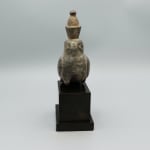Horus Figure , 664 BC - 200 BC
Granite
12.3 x 5.5 x 8.5 cm
4 7/8 x 2 1/8 x 3 3/8 in
4 7/8 x 2 1/8 x 3 3/8 in
CC.40
Further images
-
(View a larger image of thumbnail 1
)

-
(View a larger image of thumbnail 2
)

-
(View a larger image of thumbnail 3
)

-
(View a larger image of thumbnail 4
)

-
(View a larger image of thumbnail 5
)

-
(View a larger image of thumbnail 6
)

-
(View a larger image of thumbnail 7
)

-
(View a larger image of thumbnail 8
)

-
(View a larger image of thumbnail 9
)

When the god-king Osiris was killed by his brother Set, and went to the underworld to rule over the dead, the world descended into chaos as his brother and son...
When the god-king Osiris was killed by his brother Set, and went to the underworld to rule over the dead, the world descended into chaos as his brother and son battled over the succession. After a series of challenges, adjudicated by a panel of gods, Osiris’ son, the falcon-headed Horus, emerged the victor. As the era of the gods gave way to the time of humans, the living Pharaoh became the embodiment of Horus on Earth. Figures of Horus as a falcon became important symbols of pharaonic power and legitimacy. The worship of Horus spanned the whole of Ancient Egyptian history, from the Predynastic Period all the way to the Ptolemaic and Roman Periods.
This figure of Horus can be conservatively dated to somewhere between the Saite Period (664 BC – 525 BC) to the early Ptolemaic Period (from 332 BC) by the shallow form of the orbital ridge. It depicts Horus as a falcon; the species is unknown, but it is likely a lanner (Falco biarmicus) or peregrine falcon (Falco peregrinus). The figure has wide, watchful round eyes, a short hooked beak, and a proud chest. The wings meet just above the tail, which is now missing. The legs, too, only exist in nubs. Horus wears the double crown of Egypt, the pschent, which combines the bottle-shaped white crown of Upper Egypt (hedjet) and the bucket-shaped red crown of Lower Egypt (deshret), and symbolises the unification of the Kingdom at the beginning of Egyptian history. The crown has become detached at some point in the object’s history, and has been restored in modern times.
The artist had a good eye, capturing the essence of the bird’s form while remaining in accordance with the strict canon of proportions that defined Egyptian art. This is a stylized interpretation, but one that closely mimics the beauty of nature, and clearly results from a long apprenticeship in observing natural forms. This small figure was probably a votive figure that represented the private devotion of an Egyptian individual to the god.
This figure of Horus can be conservatively dated to somewhere between the Saite Period (664 BC – 525 BC) to the early Ptolemaic Period (from 332 BC) by the shallow form of the orbital ridge. It depicts Horus as a falcon; the species is unknown, but it is likely a lanner (Falco biarmicus) or peregrine falcon (Falco peregrinus). The figure has wide, watchful round eyes, a short hooked beak, and a proud chest. The wings meet just above the tail, which is now missing. The legs, too, only exist in nubs. Horus wears the double crown of Egypt, the pschent, which combines the bottle-shaped white crown of Upper Egypt (hedjet) and the bucket-shaped red crown of Lower Egypt (deshret), and symbolises the unification of the Kingdom at the beginning of Egyptian history. The crown has become detached at some point in the object’s history, and has been restored in modern times.
The artist had a good eye, capturing the essence of the bird’s form while remaining in accordance with the strict canon of proportions that defined Egyptian art. This is a stylized interpretation, but one that closely mimics the beauty of nature, and clearly results from a long apprenticeship in observing natural forms. This small figure was probably a votive figure that represented the private devotion of an Egyptian individual to the god.








